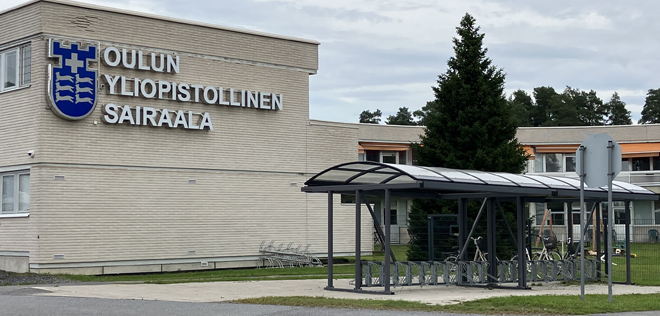Study: Patient choice reform reduced waiting times in public hospitals
Despite long distances between hospitals in Finland, the patient choice reform for planned surgeries encouraged patients to seek treatment outside their own health care district. This reduced waiting times and ensured that existing resources were used more efficiently, a new study reveals.

Researchers Mika Kortelainen and Tanja Saxell from the VATT Institute for Economic Research are a part of an international research group investigating the effects of greater patient choice among public hospitals. The study shows that, given the greater opportunity to choose their hospital, patients are willing to seek planned surgical treatment outside their own health care district. This way patient choice delivers faster access to treatment and improves the use of existing resources.
"Long waiting times are typical for common hospital treatments such as hip and knee replacement surgeries, but there are large regional differences in how fast patients receive care. By promoting patient choice, more patients could be encouraged to seek treatment in hospitals with shorter waiting times. This way, patients receive care faster and existing hospital resources could be used more efficiently", says senior researcher Tanja Saxell.
Teaching hospitals attracted more patients
The study examines a regional patient choice reform carried out in Finland in 2007. Four health care districts, encompassing approximately one fifth of the Finnish population, agreed to extend patient choice to planned surgeries. Prior to the reform, patients were typically referred to the closest hospital within their own health care district. After the reform, the patients could choose a hospital in any of the health care districts in the reform area.
Following the reform, patients increasingly sought surgical care in large teaching hospitals. For hip and knee replacements, the probability of choosing a teaching hospital instead of a non-teaching hospital increased by 10–14 percent after the reform. For all musculoskeletal surgeries, this probability increased by three percent.
Shorter waiting times and more patients treated
The reform improved the utilization of existing hospital resources. This reflects surgical care being increasingly concentrated in large teaching hospitals, which have higher treatment capacity and generally better resources compared to other hospitals. In the reform area, waiting times were cut by 36 percent for hip and knee replacements and 23 percent for all musculoskeletal surgeries.
In hospitals, the length of stay for musculoskeletal surgeries was reduced by 8 percent. This was achieved with little impact on measures of clinical quality, such as emergency readmissions or post-surgery complications. Given the shorter hospital stays, more patients were treated. Furthermore, the total surgical expenditure did not increase on average after the reform.
"Distances between hospitals can be very long in Finland. Despite this, according to our research, patients are willing to use their right to seek care outside their own health care district. Greater choice can improve patient allocation and ensure that existing resources are being used more efficiently. Given the potential benefits of greater choice, patient choice should be promoted more widely, for example, by producing easy-to-use information on waiting times and quality of care on a national level", says Tanja Saxell.
Quasi-experimental research setting
The regional reform provides a source of quasi-experimental variation in patients’ opportunities to choose their hospital. The reform only affected the reform areas, leaving patients and hospitals in other areas unaffected. The researchers use a difference-in-differences approach together with comprehensive administrative datasets to estimate the effects of the reform. The datasets are nationwide and include patient-level data on hospital admissions and discharges as well as hospital productivity records from the Finnish Institute for Health and Welfare.
In 2007, four health care districts in South-West Finland carried out a regional patient choice reform for planned surgeries. The reform’s aim was to improve the quality of care, increase competition between hospitals, ensure patients’ access to care and tackle elective care backlogs. The reform was publicized, for example, by the Finnish public broadcasting company YLE.
The reform was inspired by earlier patient choice reforms conducted in many other Nordic countries and the United Kingdom, but in contrast to these national reforms the Finnish reform was regional. Since 2014, patients have had the right to choose any public primary care unit or hospital in Finland as their place of treatment in non-emergency care.
The research—published as a working paper by the VATT Institute for Economic Research—was conducted by researchers at the VATT Institute for Economic Research, University of York, University of Missouri, Finnish Institute for Health and Welfare, Aalto university, Helsinki Graduate School of Economics, University of Turku, and University of Jyväskylä.
Research publication:
Mika Kortelainen, Liisa T. Laine, Konsta Lavaste, Tanja Saxell and Luigi Siciliani (2023) Improving Performance Through Allocation and Competition: Evidence from a Patient Choice Reform? VATT Working papers 156.
Keywords
Contacts
Tanja SaxellSenior ResearcherVATT / Julkiset palvelut ja paikallinen julkistalous
Tel:+358 40 304 5574tanja.saxell@vatt.fiDocuments
VATT Institute for Economic Research specializes in applied economic research. We produce high-quality scientific research to evaluate economic policy and support evidence-based policy making. Find out more about our work at https://vatt.fi/en/
Alternative languages
Subscribe to releases from Valtion taloudellinen tutkimuskeskus VATT
Subscribe to all the latest releases from Valtion taloudellinen tutkimuskeskus VATT by registering your e-mail address below. You can unsubscribe at any time.
Latest releases from Valtion taloudellinen tutkimuskeskus VATT
VATT: Kehysriihen veronalennukset uhkaavat johtaa entistä voimakkaampaan julkisen talouden sopeutustarpeeseen2.6.2025 07:02:00 EEST | Tiedote
Kehysriihessä tehdyt veronalennukset eivät maksa itseään takaisin, koska kyse on pysyvästä verotulojen pudotuksesta. Näin arvioidaan VATT:n lausunnossa eduskunnan valtiovarainvaliokunnalle.
Tuhkarokkorokotuksesta syntyy yllättäviä pitkäaikaishyötyjä yhteiskunnalle – Lasten rokotuskattavuus laskenut huolestuttavasti useilla hyvinvointialueilla28.5.2025 07:00:00 EEST | Tiedote
Tuhkarokko voi aiheuttaa vakavia jälkitauteja ja johtaa jopa kuolemaan. Viimeaikaiset tutkimukset ovat kuitenkin osoittaneet, että tuhkarokkorokotteen on havaittu saavan aikaan yllättäviäkin pitkäaikaishyötyjä. Siitä huolimatta Suomessa tuhkarokkorokotuksen kattavuus on laskussa useilla hyvinvointialueilla. Tilanne on THL:n keräämien rekisteritietojen mukaan erityisen huolestuttava Etelä-Karjalan, Länsi-Uudenmaan, Ahvenanmaan, Pohjois-Pohjanmaan ja Kanta-Hämeen hyvinvointialueilla, joissa kattavuus jää alle 90 prosentin.
VATT: Perintöveron korvaaminen luovutusvoittoverolla ei toisi merkittävää talouskasvua2.4.2025 10:00:00 EEST | Tiedote
Valtion taloudellisen tutkimuskeskuksen (VATT) selvityksen mukaan perintöveron korvaaminen luovutusvoittoverolla ei olisi kansantalouden näkökulmasta perusteltua. ”Muutos ei kiihdyttäisi merkittävästi talouskasvua. Verotulot kuitenkin laskisivat huomattavasti”, sanoo VATT:n selvitystyöryhmää vetänyt johtava tutkija, tutkimusohjaaja Tuomas Matikka.
Väitöstutkimus: Julkisen liikenteen hintojen alentaminen vähentää autoilua, mutta on ilmastotoimena kallis21.3.2025 07:03:42 EET | Tiedote
Tuoreen tutkimuksen mukaan Helsingin seudun joukkoliikenteen lippujen hinnanalennus vähensi autoilua ja CO2-päästöjä. Jokaista vähennettyä hiilidioksiditonnia kohden toimenpide oli kuitenkin kallis verrattuna muihin ilmastotoimiin.
Tutkijaesittely: Tutkimusprofessori Teemu Lyytikäinen19.3.2025 07:00:00 EET | Blogi
Tällä kertaa tutkijaesittelyssä on Teemu Lyytikäinen, joka nimitettiin VATT:n tutkimusprofessoriksi joulukuussa 2024. Teemu on mukana useissa tutkimusprojekteissa, jotka liittyvät muun muassa kuntatalouteen ja asumiseen. Lue lisää Teemun tekemästä tutkimuksesta.
In our pressroom you can read all our latest releases, find our press contacts, images, documents and other relevant information about us.
Visit our pressroom